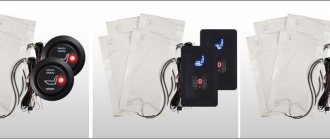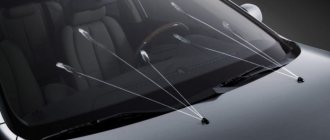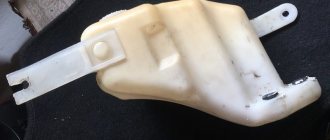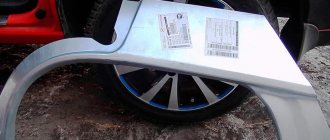The last decade in the automotive industry has been marked by the motto “safety first.” As part of this initiative, new active/passive systems are being developed to ensure maximum safety for the driver and passengers of vehicles. But, unfortunately, most of these systems turn out to be unavailable in the basic configurations of even expensive models, not to mention budget cars of classes B and C.
In particular, heating the windshield wiper reservoir can now be found in new cars not so often, although the implementation of this function does not require significant modernization of the car design.
That is why many car owners decide to heat up the washer fluid reservoir with their own hands if it is not available. Today we will talk about how to do this.
Why do you need to heat up the “anti-freeze”?
Many of you are reading this material with poorly concealed bewilderment: why heat a liquid that does not freeze? In fact, any liquid is characterized by such an indicator as viscosity. Everyone knows, for example, that at low temperatures, motor oil thickens. Exactly the same behavior is typical for “anti-freeze”, which is based on isopropyl or ethyl alcohol. In severe frosts, the viscosity of the liquid becomes thick, so it sprays much worse (the droplets are larger in size and there are fewer of them), and the spray range is reduced. All this leads to a decrease in the quality of cleaning the windshield from dirt, snow and ice.
We also do not forget that the pump motor has to work with increased load, which does not help to extend its service life. It is no coincidence that, according to car service statistics, malfunction of windshield washer pumps is one of the most common breakdowns.
But even greater unpleasant consequences are the use of low-quality “anti-freeze products”, for which the freezing temperature declared and indicated on the label does not correspond to reality. It is not that rare that the threshold of -30°C specified by the manufacturer turns out to be shifted by 10-15 degrees to the upper region, and already at minus 15 degrees such a liquid freezes, turning into ice. There is no need to explain what this means - the wipers in this case will simply spread dirt over the entire accessible area, significantly impairing visibility of the road. Note that the risk of purchasing such an “anti-freeze” is quite high, and car owners themselves often dilute the factory fluid in order to save money, aggravating the situation.
But there is an effective way to solve the problem - heating the “anti-freeze”. And it’s good if such a tool is installed on the car as standard. But even in its absence, one should not despair; installing such a system is a fairly simple task if desired.
And in addition
- It is very important to ensure that during severe frosts the liquid supplied to the glass from the nozzles is not too hot. The temperature difference between the washer fluid and the windshield can damage the latter. Cracks may occur. Therefore, at 25–30 degree frosts, the heating system should be used with caution.
- In severe frosts, even with a heating system for the tank, it is better to use a concentrated anti-freeze agent. It will help prevent liquid from freezing on the surface of your car's windshield and your windshield wipers from freezing.
How to make a heated windshield washer reservoir with your own hands
Our country has always been famous for its folk craftsmen, who ingeniously improved the products of the domestic automobile industry, which, as a rule, are not distinguished by much thought. But, as it turned out, foreign cars are not perfect, and here, too, there is a fertile field for the manifestation of one’s creative abilities. It is not surprising that there are a considerable number of options for installing a heating system for the washer reservoir; just enter the corresponding query in the search bar.
But they all use one of three schemes:
- using the coolant of the power unit cooling system as a coolant;
- electrical methods of heating non-freezing liquid;
- the use of ready-made kits focused on the first or second method of providing heating of the liquid liquid.
Let's take a closer look at all three options described above.
conclusions
Good visibility for the driver is important at any time of the year, but this is especially true in winter conditions. Many people are capable of heating the windshield washer reservoir with their own hands. For the operation of the device, two options are used: the engine cooling system or electrical elements.
The option of connecting to the SOD is quite labor-intensive and requires certain skills. Things are somewhat simpler with the implementation of electric heating. Excellent results are demonstrated by an integrated approach to the problem, including insulation of supply tubes and arrangement of heating of nozzles.
I’ll start by describing in chronological order the latest movements with the machine.
Towards the end of December, it was time to carry out regular maintenance. The work is generally standard, but with some minor surprises.
1) Changed the engine oil (Motul 8100 X-clean 5w40). Since the previous filling 10 thousand km ago, the oil has not left, well, at most 50-100 grams. And this is with my driving style and waddling sideways. In general, thanks to the machine










